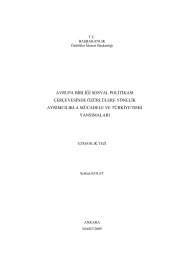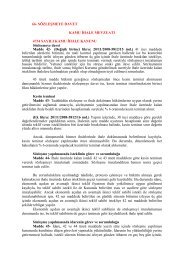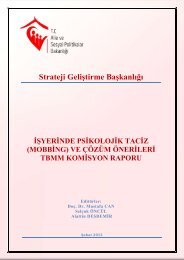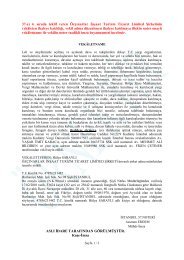Sosyal PolÄ°tÄ°ka tÄ°ka - EÄitim ve Yayın Dairesi BaÅkanlıÄı - Aile ve ...
Sosyal PolÄ°tÄ°ka tÄ°ka - EÄitim ve Yayın Dairesi BaÅkanlıÄı - Aile ve ...
Sosyal PolÄ°tÄ°ka tÄ°ka - EÄitim ve Yayın Dairesi BaÅkanlıÄı - Aile ve ...
- No tags were found...
You also want an ePaper? Increase the reach of your titles
YUMPU automatically turns print PDFs into web optimized ePapers that Google loves.
A CRITICAL ASSESSMENT ON THE CONDITIONAL CASH TRANSFER PROGRAMME<br />
IN THE CONTEXT OF GENDERED POVERTY IN TURKEY<br />
Mehmet Ali KÜÇÜKÇAVUŞ<br />
in<strong>ve</strong>stment in children’s human capital such as regular school attendance or regular<br />
check-ups. In fact, labour and employment-requirements that aimed to establish a<br />
link between a cash transfer and behaviour change were already introduced in the<br />
welfare reforms through the “Temporary Assistance for Needy Families” in the United<br />
States of America (USA) and the “New Deal” in the United Kingdom (UK) in the mid-<br />
1990s before CCT programmes (De la Brière and Rawlings, 2006, p.7). CCT programmes<br />
still represent a departure from the traditional welfare programmes not only by<br />
responding short-term needs but also aiming to impro<strong>ve</strong> human capital de<strong>ve</strong>lopment<br />
(De la Brière and Rawlings, 2006, p.6). In addition this, there are also <strong>ve</strong>ry practical<br />
and innovati<strong>ve</strong> mechanisms in structure of CCT programmes:<br />
CCT programmes introduced unique targeting mechanisms, based on scoring formulas<br />
and means tests to identify beneficiaries. These mechanisms enable to prioritize<br />
the household below a particular income le<strong>ve</strong>l and a specific geographical region<br />
more precisely than in traditional social assistance programmes;<br />
Payments are made on the condition of fulfilling specific programme requirements;<br />
and<br />
Payments or stipends for the girls are higher than boys. They are usually paid to mothers<br />
(International Po<strong>ve</strong>rty Centre, 2008, p.3).<br />
As the payments are made to mothers and stipends of girls are higher than boys under<br />
CCT programmes, it is argued that CCT programmes ha<strong>ve</strong> a strong gender aspect<br />
as a kind of po<strong>ve</strong>rty alleviation and social assistance programmes.<br />
The first CCT programme is the Mexican CCT programme which was firstly called<br />
Progressa, then Opportunades and was launched in 1997. This programme was later<br />
followed by other CCT programmes in various countries Brazil, Chile, Honduras,<br />
Colombia, Nicaragua, Jamaica, Panama, Indonesia, Zambia, Malawi, Turkey and New<br />
York City, USA (Fernald, et al., 2008, p.828 and Ricco, 2010).<br />
Although these programmes are designed for and implemented in different countries,<br />
they basically transfer cash benefits for poor families depending on fulfilment of<br />
certain conditions either regular school attendance of their children or regular health<br />
check-ups to strengthen human capital of the poor families. The primary objecti<strong>ve</strong> of<br />
enforcing such conditions in CCT programmes is rationalized to eliminate “the intergenerational<br />
transmission of po<strong>ve</strong>rty” through in<strong>ve</strong>sting long-term de<strong>ve</strong>lopment of<br />
human capital in poor families while traditional social assistance programmes attach<br />
a priority to short-time po<strong>ve</strong>rty alleviation (Rawlings and Rubio, 2005, p.29).<br />
55

















